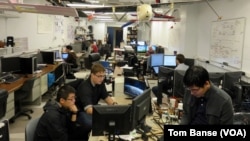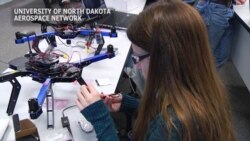Drones could be a key technology of the future, and job prospects for those who know how to design, build and control them look good. That's why colleges and universities around the USA are starting to offer degrees in unmanned aerial systems.
One of them is the University of Washington in Seattle. Aeronautics research scientist Christopher Lum works with students in the Autonomous Flight Systems Laboratory to explore how civilian drones can safely share the skies with manned aircraft.
Senior Ryan Valach savors his three years in the autonomous flight lab. "One of the coolest parts is the collaboration we get to do with industries and all the cool technology we work with. It is definitely an opportunity that a lot of students don't usually get."
Transformation
Aeronautics and Astronautics master's student Ward Handley wasn't as sold at first. "I specifically decided, no I do not want to work on drones because of the privacy issues," he recalled. But then came an offer for a paid position in a drone lab... and Handley had a transformation.
"I'd like to see them used for good rather than ill," he said. 'I think there are enough good applications for them that are really useful to society so that it is worthwhile to pursue these things."
WATCH: Related video
Students work on building and flying drones at the University of North Dakota, the first university to offer an unmanned aerial systems degree, and one of the schools selected by the FAA for the national academic research consortium, the "Center of Excellence for Unmanned Aircraft Systems." (Video courtesy University of North Dakota Aerospace Network)
But new recommended FAA rules will likely require all drones be registered in a giant database, and evolving regulations for drone flying present lots of hurdles for students looking for hands-on piloting experience. A challenge for many academic unmanned aerial systems programs is finding a place to fly legally.
At Blue Mountain Community College in Pendleton, Oregon, students fly inside the college gym.
In Seattle, UW student Alec Bueing shows off his department's flight test range for small copters, explaining "[It's] just a conference room that we move the tables and chairs out of the way for, make sure to bring the blinds down so if it happens to get out of control toward the windows we minimize any damage."
Federal regulations
Why indoors? Lum explains it takes a very long time for everyone besides hobbyists to get official permission to fly a drone outside.
"The federal regulations are a little bit stifling on that front," he said. "We need to file for paperwork. We need to register our aircraft. We need to obtain what is called a Certificate of Authorization - or waiver."
That can take months.
The Federal Aviation Administration aims to replace its current case-by-case examination of drone authorization requests with a national rule for civil and commercial UAS operations later in 2016.
“At this time, Kansas State University is the only school with a... regulatory exemption to offer unmanned aircraft flight instruction to students [outdoors]," an FAA spokesperson wrote in an email. "We are currently evaluating similar petitions from a number of other universities and colleges.”
Kansas State is one of 15 universities selected by the FAA to be part of a national academic research consortium called the "Center of Excellence for Unmanned Aircraft Systems." This comes with federal grant funding to expand research and training. Also in the consortium is UND, the first university to offer a UAS degree, one of six test sites.
For their part, UW's Lum and some of his students have relocated to more accommodating Australia for the past two summers to log outdoor flying time. A Western Washington University professor took his department's two drones across the border to Canada for the same reason.











